
This is the cover of the November 1937 issue of an American pulp magazine called Dare-Devil Aces. I vaguely knew about the existence of these aviation adventure magazines, or air pulps, but I’d assumed they were filled with stories of chivalric air combat of the Great War. Many undoubtedly were, but that’s not what this cover illustrates. The biplane in RAF colours is a Hawker Fury II (I think; a Nimrod could also fit [edit: actually a Fairey Fantôme]); the bombers are German Dornier Do 23s. And the ocean liner looks to be RMS Queen Mary. In other words, this is all 1930s technology and it’s a scene from the next war, not the last one.
There was a whole ecosystem of such magazines, starting with Air Stories in 1927; there was even briefly a British equivalent, Wings, which lasted for 10 issues between in 1934 and 1936. Dare-Devil Aces was one of the longer-lived ones, running from February 1932 to November 1946. Covers and story listings for most issues are available online (Galactic Central is the most complete source, though the scans are bigger at Age of Aces and Pulp Covers; these have some of the inside articles or pages as well).
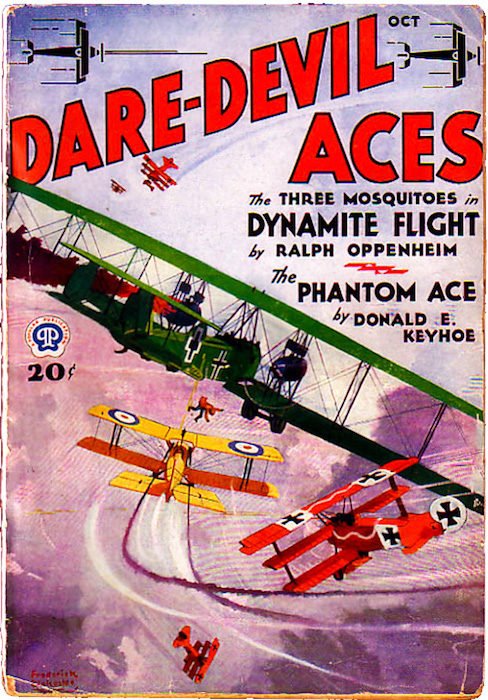
Early issues did in fact draw on the First World War. For example, this is the cover for October 1932. A Riesenflugzeug is being attacked by a British fighter which in turn has the Richthofen circus on its tail. A feature by the artist, Frederick Blakeslee, gave ‘The Story Behind the Cover’, in the case ‘The Giant Bomber’, which in English usually means a Zeppelin-Staaken R.VI, but this one appears to have an open cockpit rather than a closed one. (Incidentally, the author of ‘The Phantom Ace’, Donald E. Keyhoe, was a former Marine aviator and publicity manager for Lindbergh, but later became even better known as one of the first ufologists.)
In any case, the covers apparently didn’t usually match the contents of the issue. For the first couple of years, the major theme is air-to-air combat, mostly dogfighting rather than bomber interceptions, set against a background of clouds like the above.

For a few issues in late 1934, there’s a switch to scenes showing air raids on more or less military targets. For example, from the September 1934 issue here are some RAF Airco DH.10s (I think! [edit: actually Boulton Paul Bourges]) attacking a heavily-defended bridge — albeit in the centre of an ancient cathedral town.
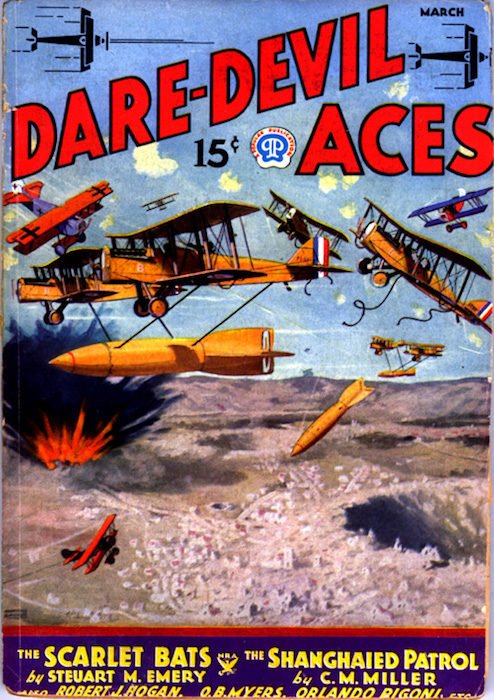
Then there’s another switch: from December 1934 the covers are still set in the Great War, but now with ahistorical and often superscientific weapons thrown in: death rays, nets, buzzsaws, what seem to be poison gas bombs. I like these giant bombs from March 1935, so big they need two aircraft to carry them — but how did they even take off?
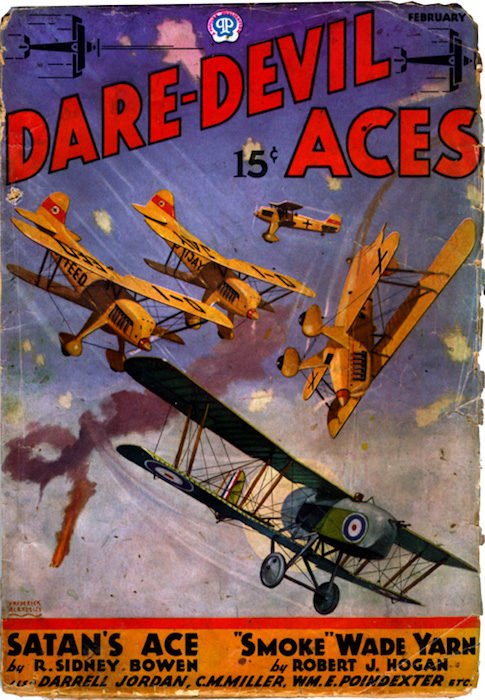
From October 1935, it’s the aircraft which are ahistorical or simply fantastic. For example, the February 1936 cover has a Vickers Vampire, a First World War fighter which never made it out of prototype, tangling with Heinkel He 51s (in Nazi markings) which didn’t enter service until 1935. Why? I have no idea!
But my favourite period is the next one, which lasts right into the Second World War. It consists of contemporary service aircraft in exaggeratedly dramatic and usually implausible battle scenes, involving both aerial combat and bombing — very much in the Hendon style. What makes these combat scenes so interesting is that they often include aircraft which aren’t often seen depicted in combat because they were retired before the war (or should have been).

SEE Fairey Hendons attack a battleship! (August 1936)
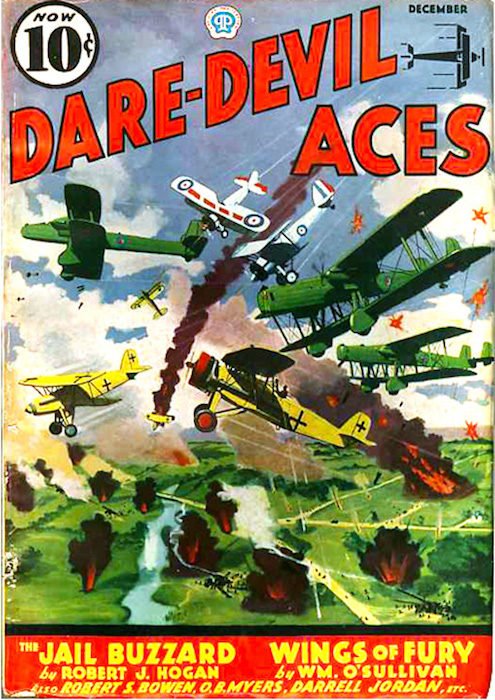
THRILL as Handley Page Heyfords bomb really big artillery guns! (December 1936)

GASP at some of the fugliest bombers of the Third Republic! (May 1937)

GO “OH REALLY?” as Airspeed Oxfords [edit: actually Military Envoys] lay waste to an aerodrome! (December 1937)
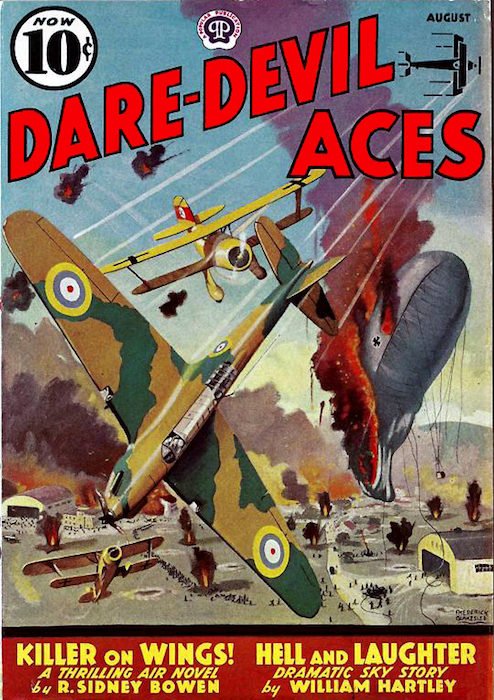
THINK “YEAH, THAT’S PROBABLY RIGHT” as a Fairey Battle struggles to avoid a few biplane fighters! (August 1938)
While some of the scenarios do seem to be inspired by the Spanish Civil War, most of the covers clearly represent near-future wars. Not until well into 1940 do they clearly attempt to show the kind of combat that was actually taking place in the war then raging in Europe.
Fascinatingly, while the bombers switch to monoplanes quite early on, the fighters they encounter are overwhelmingly biplanes right up until March 1940. The Me 109 appears in July 1939 but the Hurricane doesn’t feature until July 1940, and the Spitfire not until October 1940. We now associated these fighters with the height of late 1930s airpower modernity, but apparently this was not universally the case.

Oddly for an American magazine, very few covers show American aircraft. They are overwhelmingly British, sometimes French, versus Germans. A few of the First World War covers show AEF aircraft, but only a few. Here’s another exception from April 1937, with Japanese and American fighters duking it out over New York City — but even in this case the British are here to lend a hand. I’m not sure what explains this Anglophilia: even in the Second World War, the RAF dominates the covers right up until early 1943.
So there were some interesting things going on with Dare-Devil Aces. And it was pretty mundane next to Dusty Ayres and his Battle Birds, which in turn was downright unimaginative compared with G-8 and his Battle Aces…
![]() This work is licensed under a Creative Commons Attribution-NonCommercial-NoDerivatives 4.0 International License.
Permissions beyond the scope of this license may be available at http://airminded.org/copyright/.
This work is licensed under a Creative Commons Attribution-NonCommercial-NoDerivatives 4.0 International License.
Permissions beyond the scope of this license may be available at http://airminded.org/copyright/.



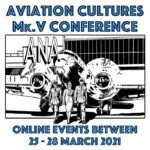
I’ve still got quite a few of these stashed away amidst a mostly science fiction pulp collection. What an unusual genre emerged, with a free mixing of times and technologies, and the weird menace aspect that turns up especially in G-8, as you note at the end. Great article!
I wonder if the artists were using The Aeroplane for their references? Besides, drawing a Heyford is fun!
Some of them are definitely based on press photos of the era, Erik, notably the Airspeed Military Envoys attacking the airfield relate to the shots published at the time of the (rare) type.
What’s interesting, among all the interesting things, is that in many of the covers you show the featured aircraft at the center of the action is a limited run prototype. The Vampire, Fantome, and Bourges all had only a handful of prototypes and never were used in combat. So does that make them exotic and unknown to the viewer?
Or is this something that also hints at what-if, much like the Luft ’46 concepts.
Paul:
It’s a really interesting genre, almost a mash-up we might say now — I might do a followup on G-8. Would you say that the contents match up to the covers, either in content or in imagination?
Erik and JDK:
Yes, I agree, it’s almost certain that the inspiration came from Flight or Aeroplane (and not their American counterparts, given the rarity of American types). For one thing, there would be no better source for high-quality photos of new and interesting aircraft (Jane’s maybe, but that’s once a year; newspapers and non-specialist magazines would only have sporadic aircraft photos and not always good ones). You can imagine the artists scouring the latest copy fresh off the boat for cover ideas…
DSchwartz:
My sense is it’s not quite as considered as Luft ’46 (though I do like that feeling that it’s kind of counterfactualish without actually being a counterfactual); rather it’s about exoticism and variety; even in the war years there aren’t as many Spitfires or Hurricanes as you might expect, whereas it’s not uncommon to find a Defiant, an Airacobra, even a Skyrocket in RAF colours. A magazine cover is supposed to stand out and make you look, and that goes double for the pulp era. Bright colours, cool aircraft, ludicrous action that the magazine contents probably can’t live up to — too late, you’ve already bought it!
Considering that the occult intelligence thriller is now a thing (I’m looking at you Charlie Stross) it’s a little surprising G-8 hasn’t been rediscovered and repurposed; maybe if “Sky Captain and the World of Tomorrow” had been a commercial success.
Yes, it’s a shame Sky Captain didn’t do better, or inspire a wave of dieselpunk films…